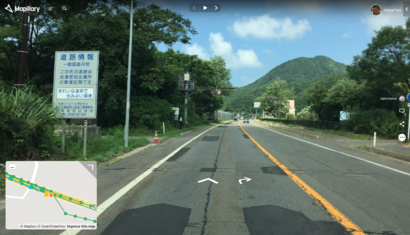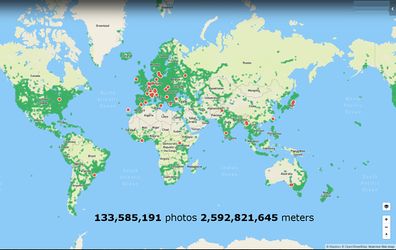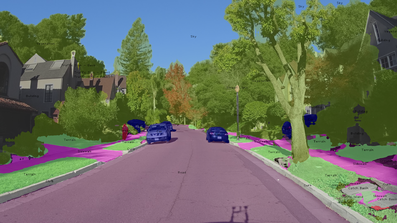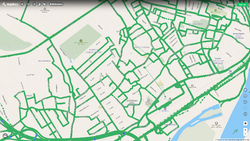Mapillary
| Mapillary | ||||||||||||||||||||
|---|---|---|---|---|---|---|---|---|---|---|---|---|---|---|---|---|---|---|---|---|
| Author: | Facebook Inc. | |||||||||||||||||||
| License: | proprietary (web and app) and CC-BY-SA (images) (free of charge) | |||||||||||||||||||
| Platforms: | Android, iOS, and Windows Phone | |||||||||||||||||||
| Status: | Active | |||||||||||||||||||
| Version: | 6.4.32 (Android / 2024-07-16), 6.0.3 (iOS / 2024-07-02), 1.2.0.0 (Windows Phone / 2016-xx-yy) [1],[2] (2024-08-22) | |||||||||||||||||||
| Language: | English
| |||||||||||||||||||
| Website: | https://www.mapillary.com | |||||||||||||||||||
| Install: | ||||||||||||||||||||
|
Collect street-level imagery |
||||||||||||||||||||
| ||||||||||||||||||||


Mapillary (mapillary.com) is a service for sharing geotagged photos developed by a Swedish startup, that was sold to Facebook in June 2020.[3][4] Its creators want to represent the whole world (not only streets) with photos.[5][6] They believe that for covering all interesting places in the world, there needs to be an independent, crowdsourced project and a systematic approach to cover interesting areas. Services like Google, having especially equipped cars with camera mounts, are not going to be able to cover the world in sufficient detail.[5] According to them, the local knowledge is almost unbeatable, and people know what really matters in capturing a photo.[5] They are interested in coverage of any outdoor place and this can contribute to a system that represents the world with high level of detail.[4] Most of the "intelligence" of image processing is done on the server side using Big data technologies and computer vision, making the data collection super simple for the user. As a result, Mapillary will improve with each new photo, since all new photos are related to any existing photos in the vicinity. Here is a short presentation [7] for a brief technical overview. The idea is that the users of the data are empowered to increase coverage in areas that interest them.[5] The developers of Mapillary believe there is a place in the market for a provider of neutral and independent pictures.[5][6]
The contributors can install the Mapillary app on WindowsPhone, Android or iPhone, there are successful reports from even Jolla and Blackberry devices that can run Android apps. After registration, the user can start taking photos. In addition to supporting numerous smartphones and action cameras, Mapillary also offers a Mapillary-specific version of the BlackVue DR900 dashcam, the BlackVue DR900M.[8][9][10][11]
At developer resources, the JSON API is documented, including an embeddable Widget.
Mapillary Examples
- Map your town
- Show the way
- Share a panorama view
- Map a place
- take surveys of construction sites
- import SLR images with GPS
- Upload historic pictures and archives
The Mapillary Workflow
Mappers can primarily contribute to Mapillary by uploading their captured photo sequences. The most popular methods are either with a smartphone using the Mapillary app which is actively developed for Android and iOS (An open-source Windows app is also available) or from vehicle dashcam or action camera footage/capture uploaded via Desktop Uploader application or mapillary_tools command-line scripts. These devices can be used as long as accompanying GPS data is recorded (normally by the device itself, but possibly separately). Photos taken outside the apps can also be uploaded this way. For more information on using Mapillary, take a look at Mapillary/Data collection with Mapillary or Mapillary's help pages.
For download, there are several 3rd party options mentioned here, like https://github.com/tobesucht/mapillary_downloader, mapillary_v4_downloader.py or mapillary_jpg_download.py. (also see Image transfer tool for synchronization between Mapillary and KartaView [defunct in 2023]).
Computer Vision
Mapillary uses computer vision to recognize map features (objects) from the images, ranging from traffic signs to more experimental object and line recognition. The experimental features are based on semantic segmentation.
While serving as a useful visual aid for OSM editing, Mapillary also processes photos contributed using computer vision. Every photo is processed with identified faces and license plates blurred.
Traffic sign recognition
Traffic signs convey important information about road restrictions and junction layouts, and are mapped on OpenStreetMap using the traffic_sign=* key.
Mapillary first introduced automatic traffic sign recognition in January 2015, and about a month later launched a system for manual validation of these recognition results, in the form of a game (currently doesn't work). This feedback led to improved automated recognition results, which were further improved by using country-specific models, and later worldwide appearance groups to cover more countries using a single model. These appearance groups are documented here. A full list of supported countries can be found here.
The recognized signs are available as a data layer within the iD editor, which can be used to assist in editing the map. The data layer contains precise locations and types of traffic signs. It is also possible to export the data as a file from the Mapillary platform.
Semantic segmentation

Mapillary has also started processing photos to understand the scene and a wider variety of objects within it at pixel level. This is achieved using deep learning, which teaches the computer to identify scenes and objects, by comparing them to existing scenes and objects the computer has been shown. This led to the creation of the Mapillary Vistas dataset which includes 25,000 human annotated images which can be used to improve these algorithms. This data is not yet available in OSM editors but can be used when contributing to OSM.
As of August 2018, Mapillary has moved this feature to "beta". It provides an online interface for exploring recognized features, e.g. crosswalks, barriers, and traffic lights (full list). Unlike traffic signs, these features do not have their precise location determined by triangulation. Some "linear" features such as sidewalks are additionally matched against the OSM road map to generate line features, although these are usually not useful for mapping.
Use in OSM editors
You can easily use Mapillary photos directly when editing in OSM editors (see also #License):
- In iD there is "Photo Overlay (Mapillary)" in the "map data" settings (if you are at a location which is covered by Mapillary, you will see yellow photo markers). There's a video tutorial here on how to use Mapillary in iD.
- There is a JOSM plugin for Mapillary and an accompanying tutorial video here.
- Pic4Review, an easy editor for OSM using street-level pictures, heavily uses Mapillary pictures.
OSM community outreach
Mapillary supports a range of OSM initiatives including SotM conferences, Maptime meetups and humanitarian projects. Through a partnership with Humanitarian OpenStreetMap, Mapillary provides equipment and technical support for projects that are actively contributing OpenStreetMap. Reach out to Mapillary to find out what support may be available for your initiative.
The details of the car mounts, bike ( bicycle ) mounts and the battery packs can be found here.
License
The images on Mapillary can be used under Creative Commons Attribution-ShareAlike 4.0 International License (CC-BY-SA).[12] There is special permission to derive data from the photos for contributing to OpenStreetMap. The GPX tracks can be used without restriction. The license was changed on 29 April 2014 from CC-BY-NC to CC-BY-SA.[13]
By using Mapillary, contributors also grant Mapillary a worldwide, perpetual, and transferable license to use the photos and other content for commercial purposes.[12]
See also
mapillary=*- Associate a Mapillary picture to an OSM feature.- Photo linking - Create links between OSM features and external pictures
- Street-level imagery services - Alternatives
- Panoramax and Key:panoramax for a fully FLOSS alternative
- Mapillary/Data collection of 360 degree images with Mapillary - Description of a 360 ° image capture method with an on-board camera.
- Mapillary/Action cameras processing
- Wikimedia Commons, which until several years ago[14] had a tool to pull from Mapillary by pKey
- Mapillary Image Fetcher (GitHub) - A web-based tool to fetch and visualize Mapillary street-level imagery within a specified bounding box.
 The Future of Map Data from Street level Imagery ~ Christopher Beddow - State of the Map U.S. 2025 talk
The Future of Map Data from Street level Imagery ~ Christopher Beddow - State of the Map U.S. 2025 talk
References
- ↑ Mapillary release notes
- ↑ Updating the Windows Phone App
- ↑ Katie Paul: Facebook acquires crowdsourced mapping company Mapillary. Reuters, 2020-06-18 Archived article
- ↑ 4.0 4.1 Jan Erik Solem (CEO and co-founder of Mapillary): Mapillary Joins Facebook on the Journey of Improving Maps Everywhere. Mapillary Blog, 2020-06-18 Archived blog post
- ↑ 5.0 5.1 5.2 5.3 5.4 Welcome to Mapillary! (en), by Jan Erik Solem. Posted on 1 Jan 2014.
- ↑ 6.0 6.1 Mapillary Manifesto (en), by Jan Erik, Johan, Peter and Yubin (a.k.a the Mapillary team).
- ↑ Technical Overview (en) by Peter Neubauer
- ↑ https://www.directionsmag.com/pressrelease/9259
- ↑ https://help.mapillary.com/hc/en-us/articles/360029012811
- ↑ https://blog.mapillary.com/update/2019/06/04/customized-mapillary-dashcam-for-effortless-mapping.html
- ↑ BlackVue DR900S Series and Mapillary – Dashcam Optimized for Effortless Mapping, BlackVue.com, 7 June 2019. Archived from the original on 5 August 2020 via the Wayback Machine.
- ↑ 12.0 12.1 legal page
- ↑ Blog post
- ↑ https://github.com/lokal-profil/mapillary2commons/issues/11

